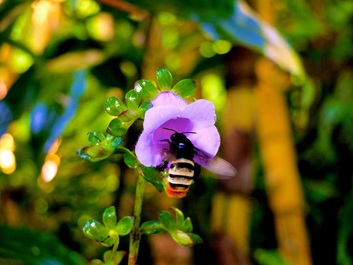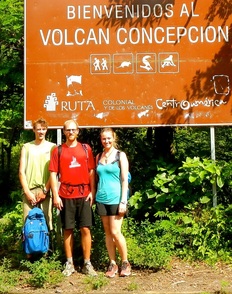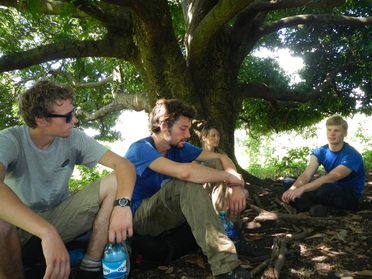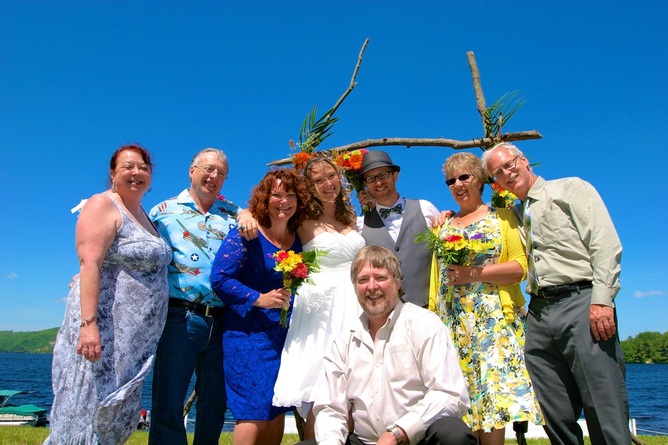"Six days, 228 miles, a close grizzly encounter, way too much sun, an incredible thunderstorm, and a constant feeling of awe - this was a trip we'll both remember for a lifetime."
6 Comments
 Merry Christmas!
We are really missing family and friends at home right now. It is pretty awesome to be spending the holidays in a surfing town though! We are volunteering at a small hotel in Santa Catalina, basically doing a lot of customer service stuff now, and also worked on some plumbing and water tank cleaning when we first got here. The hotel is located on the top of a very steep and long hill so we are getting in some amazing accidental exercise going up and down all day. There is one other volunteer here with us, Karlien who has been in the area for several weeks before us. She is very helpful in showing us around, is fun to hang out and work with, and lets us use her surf board. The board is much smaller than we have been used to - it is called a "funboard" or a "mini-malibu", which is something like a step down from a long board but wider and a bit bigger than a classic board. We tried a classic board a few days ago and it was very difficult, though we did both manage to stand up briefly once or twice. Karlien's board is a bit easier, but still a challenge compared to the long board. For me, I think I would like to work on paddling harder to catch the waves. Andrew seems to be catching more than me (on account of his manly muscles) so I think I'll go out tomorrow all day and see what I can learn. The chef that works here is also very nice. He has been here for almost two years and still loves it. The four of us have a great time hanging out. I am very happy to be spending the holidays with some cool people, even though I miss home, just a little tiny bit (but it is -38 in Whitehorse and icing over in Ontario so not THAT much, lol). We also spent a day diving in the Coiba Islands, a Island national park off coast from here. Many people call them the Galapagos of Panama, and I can certainly see why! The first dive was pretty good, we saw a ton of fish, but we didn't see anything new. Diving in the Pacific is much different than the Caribean. There aren't as many corals, but the fish are really incredible! On the second dive we saw so much more! Right when we got down to the bottom we saw a few white tip reef sharks, and then a 4-foot turtle swim by, it actually swam within probably 4-5 feet of me as I just float there, breathing and taking in the spectacle! It felt very magical. Next we saw hundreds and hundreds of jackfish, some barracuda, a devil ray, I saw a dolphin in the distance (not clearly, and heard it singing), the frog fish was insane! You have to google this thing because it is just the weirdest looking fish! And so colourful. We also saw SEA HORSES!!! They were incredible - about 6-in long, hooked onto small fan corals coloured almost the same as them. That for me was so cool! And of course we saw a bazillion other fish and moray eels etc. Amazing. Our last dive beat all our previous and probably many future dives for most memorable of all! We thought there MIGHT be a chance to see a whale shark before we arrived at our dive site, but were trying not to get our hopes up. I jumped in when the boat stopped, before I had put on my gear, and the guys on the boat threw me my BCD so I could put it on in the water. I had my goggles on and thought I would just peek into the water to see if there was a whale shark around - not actually expecting anything. And then BAM! Whale shark in the face! Literally feet away and it came right up to surface so one of its fins was out of the water! Everyone was in the water within seconds, I had my reg in my mouth but no gear on and I swam closer dragging my BCD. It was pure magic! The dive was unbelievable - we saw the whale shark (not sure if it was the same one or not) a few times deeper down where we actually watched right in front of us as it came upward with its mouth open, feeding on crill, and then turn over and wag its tail at us!!! We watched three times and used up all but the reserve oxygen in all of our tanks just trying to see it again and again. Incredible! However I was very nervous for a few of the other divers, one of whom was quite out of shape and nervous as he had already ran out of air on the first dive and had to be calmed down, and two of whom asked me if I could stick around them to share air if they ran out. I had the same amount as them, and we were 55ft deep! eeks! I should also mention that the Coiba Islands that we stopped at (two of them) were absolutely beautiful! Well we hope that the holidays are going well at home and everyone is keeping warm through all of these ice and freezing storms! Sending warmth! Love, Chelsea We have finished another CHAM Studios Original Film. I have been so excited to finish this one! This past summer before leaving on our trip I talked Oma into teaching me her secret apple strudel recipe. It was a lot of work and well worth it! I have since made it twice and have improved each time. When I am home I would like to make one for Oma using some tropical ingredients, which is what I've had to do here due to a lack of many of the ingredients in the recipe. Turns out it works well with almost any fruit (well maybe not banana, yuck). THANK YOU OMA!!!! Love, Chelsea To open in another window click here
 Michael (volunteer) and Suzanne with Biofera's cobb oven Michael (volunteer) and Suzanne with Biofera's cobb oven With a variety of nicknames which include: Suzanne-The-Man (1980s), Mojada (1990s), Rat-Lady (2001 by her slum landlord), Bat-Lady (our nickname for her because of her highly advertised bat cave), and Bandida (2010s), Suzanne is without a doubt one of the most curious characters that we've had the privilege to encounter. A passionate, enthusiastic, dedicated, intelligent (and certainly a bit eccentric) environmental and social activist, Suzanne is chock-full of a wide range of stories and experiences that, in the week we spent with her, opened our eyes to a whole new world of possibilities. She's also the first person we've met who can, through the juggling of multiple tangents, successfully tell three or four stories all at once.
Suzanne, whom we discovered at a volunteer-supported mountain retreat in northern Nicaragua, is a former Marine, cancer survivor, and peace communications innovator now engaged in an independent forest preservation and clean water initiative on 20-acres of property she purchased near Jinotega, Nicaragua. She bought the land in 2000 (without actually seeing it first), after finding that the price was right, it contained a water source, had good, fertile soil and was near a highway. Her project, which she's named "La Biosfera Reserve & Retreat", is an awesome spot where we spent a week as volunteers in October 2013. "Biosfera" (Spanish for biosphere), Suzanne says, "refers to the layer of the earth above the lithosphere, or the rock layer under the dirt and clay, through the space we breathe including gurgling brooks and mighty trees, up to around 10 km into the atmosphere. It is the place of our most intense human-nature interaction, and most rewarding scientific discovery. Now, many reserves have added it to their name - the Big Lungs - The Amazon Biosphere, Reserva de la Biosfera Bosawas, etc… It seems a little silly to call this tiny place simply La Biosfera as if it were the Be-All and End-All of forest protection," she says, pausing, "La Biosferita, maybe," and laughs.  We've been away from internet for awhile now, time to catch up on here! Andrew already posted a blog about Bolita but it didn't include pictures so here you are! It was such an interesting little place, exactly what we were hoping for. I won't re-describe everything for you but there were a couple of things I wanted to add to Andrews notes. We had so much time to hike around and watch wildlife near Bolita. The picture here is from beside our table at breakfast. Hummingbirds, bees, monkeys, macaws, doves, geckos, etc. were always nearby.  This picture shows the nearly finished product of our volunteer work. We were asked to build a shelter over the clothes-line. We used bamboo which we cut down from a nearby bush, and some scraps that were lying around from previous projects. It took us two days (4-5 hours per day) to build and was very fun! We learned a lot about working with bamboo though didn't have any instruction - all by trial and error.  At one point Andrew got a bamboo cut on his thumb. At first he looked at it a bit nervously and insisted that he was ok when I asked. After a few minutes, he got off of the stump he was standing on and wobbled to the kitchen sink. I knew he was going to faint so I grabbed a stump for him to sit on while I held onto him from behind. (Note from Andrew - it was a really hot and sunny day of hard work, I was really just quite dehydrated! =P)
This is not the first time I've had to do this so was pretty routine, lol. When he was feeling up for it we cleaned it out well and stuck a bandage on it. It really wasn't too bad, but he said he got disturbed when it began to ooze dark blood. lol, funny day. The next day I got a couple of bamboo cuts as well (nothing bad) but it is worth noting that bamboo can be pretty dangerous for that! Super sharp! We wore gloves after a few warning cuts.  We spent the last four days hiking and nature watching in Corcovado, the largest of Costa Rica’s National Parks and reportedly one of the most biologically diverse places on the planet. We saw a ton of cool creatures, took over a thousand photos & over an hour of video footage, ate a ridiculous amount of tuna and peanut butter, worked the hell out of our legs, and returned to civilization the dirtiest and smelliest we’ve ever been. All in all, a great success in our book. =)  We spent three nights at Sirena Ranger Station, deep in the heart of the park. To get there, we took what I’ll now term a “potato bus” (more on this later) from Puerto Jimenez to the end of the road at Carate, then hiked a beautiful 20 km along the Pacific coast, at times working our way up and around large rock outcrops or wading through streams and rivers. When we had originally gotten our park permits and spoken with the park staff in Jimenez, we were told we’d need to be on the trails by 6am in order to hit the final river crossing (at the Rio Claro) during low tide - crossing at high tide is not recommended, partly due to dangerous currents that could suck you out into the ocean, and partly because the deeper waters allow bull sharks and crocodiles to make their way up the river to feed on fish (or unlucky tourists). We thought we’d take this fairly seriously, and decided to catch the bus to Carate the night before the hike to allow us to get a nice, early start.  Our original plan was to arrive in Carate and find a nice secluded spot to pitch a tent, probably somewhere along the beach. As we were boarding the “bus” from Jimenez, however, we bumped into a couple frazzled-looking backpackers first words to us were, “DON’T CAMP ON THE BEACH!” – they had just returned to town after having their bags stolen from them while camping on the beach in Carate the night before. Yikes – we rode to Carate, and with only a couple hours of daylight to spare and no real idea where we’d end up spending the night, we began our trek down the beach. We were starting to get a bit worried after about 45 minutes in, until we noticed a quaint little property just off the beach with a perfectly mown lawn, impeccably kept gardens, and a few small huts – where the hell were we?? We wandered in and struck up a conversation with the only guy in sight, an older gentleman named Bob who quickly realized we were in a bit of a pickle and said he had no problem with us pitching our tent on the grass. It turned out that he and his son Kelly were on vacation from Northern California, spending a week of it on the property which was owned by a friend of a friend of theirs. In no time, Bob and Kelly were sharing with us their dinner of beans & rice (what else), some great conversation (did you guys know about this Ison comet that’s approaching extremely close to Earth?), and even the last of their special stash (which we smoked from their little seashell pipe). Chelsea and I felt like we’d stumbled into some fairytale paradise, and were happy to contribute one of our very precious chocolate covered coffee beans and a Snickers bar, which we all shared for dessert. An unexpected but most excellent evening!
 Devon is a lanky, charismatic lad who walks with the unmistakable swagger of invincible youth (either that or the hundreds of hours spent kneeling in a kayak have damaged his hips and knees). At any rate, he’s the kind of guy who you take an instant liking to, especially if he’s busted out his trademark smile and wink. In his early twenties, Devon has the wilderness wisdom of a seasoned adventure guide. Devon grew up near Ottawa, Canada and was first introduced to the idea of guiding through an incredibly supportive and committed high school Outdoor Ed teacher. We met Devon soon after arriving on the Island of Ometepe, Nicaragua, and one of the first things he said to us was “do you guys want to hike La Conception Volcano tomorrow?” Of course we agreed. He’s since become our volcano buddy, having run into one another again a couple weeks later in Leon (this time it was us who convinced him to join us on a two-day hike up Telica Volcano, despite his promise to himself to not sleep in a tent during his vacation).  Post record-fast-hike photo Post record-fast-hike photo After high school, while many of his friends were heading off to college, Devon chose to skip the education and go straight into what he knew he loved – adventure guiding. For the past 3 years, Devon has spent his summers guiding trips on the Nahanni River in the Northwest Territories, spending many weeks at a time in the wilderness with clients. Chelsea and I got a small taste of what this would be like last summer with our six-day canoe trip on the Yukon River. It was such an incredible experience for us that the thought of being able to do this for work makes us both a little envious. During the winters, Devon moves down to Northern Ontario to run dogsledding tours. Such an active lifestyle means that while the rest of us are packing on the winter pounds, Devon is doing his best to slow down his weight loss. Last dogsledding season, for example, Devon lost 20 pounds despite eating three times his usual consumption.  Working as a seasonal guide sounds like a sweet deal, giving Devon lots of time for traveling and enjoying life while he’s young and able. This summer, Devon spent six weeks traveling by himself. He chose to travel in Central America partly to scout out an alternative guiding gig for his winters (apparently there’s some decent class 4/5 whitewater in Costa Rica and Nicaragua).  Our parentals! Our parentals! We have finally uploaded the last batch of our wedding photos as one of the original photographer's discs was corrupted and we had to wait for a new one. Most of the missed pictures were the family ones! So we are very very happy to finally have them.
We have added them to the "Professional Photos" section on our Wedding Page. ENJOY! The last few weeks have been a blast! After a couple action-packed weeks with my parents (so glad you guys were able to visit!), we decided to get back to nature and spent the last week at an incredible hostel called La Bolita located on the edge of Corcovado National Park. The place was great – exactly what we’d originally had in mind when we first planned on visiting Costa Rica. Although it was a bit of an adventure to get to ...
take a colectivo (mini-bus) about half an hour along the world's bumpiest road from Puerto Jimenez to Dos Brazos del Tigre, a town of about two hundred people. Once there, walk five minutes to the edge of town and then hike for half an hour up a steep jungle path, at one point wading through the Rio Tigre (don't worry, there aren't any tigers). ... for us this just added to the wonder of the place. Every morning we awoke to the sunrise and the sound of howling monkeys and screaming macaws (why does such a beautiful bird have to sound so horrible?), and spent the day hiking, nature-watching, relaxing in hammocks, and doing a bit of volunteer work. How could we ever go back to an office job after this?? Situated on sixty hectares of land that once contained a banana plantation, Bolita consists of a couple dorm buildings, a kitchen, a bathroom & shower building (with flush toilets), and a series of hiking trails through the old plantation and surrounding jungle. One morning we did an awesome hike that took us a couple hours through the jungle and up to a waterfall, after which we followed the Rio Tigre for a couple hours back down, hiking in water anywhere from ankle- to armpit-deep. We saw howler monkeys, white-faced (capuchin) monkeys, a couple small snakes, and a few jesus christ lizards running across the water and earning their names – amazing! We also ran into a couple local oreros (gold miners) panning for gold, which was a bit of a surprise for us. We were later told that there's a whole shanty town of gold miners who live in the jungle a four hour hike from town and pan various parts of the river. Because we stayed as volunteers, in exchange for about 20 hours of work per week, we got free accommodation along with unlimited beans & rice – finally a volunteer gig where we aren’t working AND paying. And since we didn’t realize there would be next to no groceries available in town, we ate nothing but beans & rice for the first couple days and saved a bunch of money on food (at least we had brought some hot sauce). Luckily, the owner Val was nice and picked us up a few things during her weekly trip to Puerto Jimenez, letting us to cook up some of the best pasta ever. The volunteer work was enjoyable, and we spent a couple days putting together a rain shelter for the clotheslines. We felt like proper rainforest pioneers chopping down a couple tall bamboo trees, splitting and cutting the bamboo, and lashing together a beautifully-engineered structure. Spending the week at the edge of Corcovado National Park has got us really excited for our next adventure – four days at La Sirena ranger station deep in the park. The plan is to catch a bus to Carate, the small town at the edge of the park, then early the next morning set out for the 20 km hike in along the beach. If we’re lucky, during our stay we’ll get to see tapirs, giant anteaters, pumas, jaguars, ocelots, crocodiles, bull sharks, a load of monkeys, and a plethora of frogs, lizards and birds. Also, if we’re lucky we won’t be seeing any of the many kinds of large, venomous snakes. Apparently there’s a very poisonous snake called the bushmaster (insert inappropriate comment here) that grows to be over three metres long and has been known to be aggressive, even at times chasing people through the jungle (or perhaps here). We’ll definitely have our hiking sticks and machetes out and will be ready to defend ourselves. =) We haven’t had much internet access lately and so haven’t had a chance to upload any photos, but once we’re out of the park and have settled somewhere in Panama we’ll be able to catch up and share some more stories. Until then, Pura Vida! - Mandrew |
 RSS Feed
RSS Feed